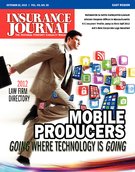Workers with access to paid sick leave are 28 percent less likely overall to suffer nonfatal occupational injuries than workers without access to paid sick leave, according to a new study from the National Institute for Occupational Safety and Health (NIOSH) in Washington, D.C.
The study found that workers in high-risk occupations and industries — such as construction, manufacturing, agriculture, and health care and social assistance — appear to benefit most from paid sick leave.
The NIOSH study, by Abay Asfaw, Regina Pana-Cryan, and Roger R. Rosa, was published in the American Journal of Public Health.
The authors suggest that by providing an income, paid sick leave might keep some people who are sick from going back to work before they are ready, thereby making workplaces safer.
The 1993 Family and Medical Leave Act requires employers to provide up to 12 weeks of leave to eligible workers. However, this does not have to be paid leave.
The researchers said that about 43 percent of U.S. private sector workers reported having no access to paid sick leave. The study used data on 38,000 working adults.
The authors conclude that improved access to paid sick leave might help businesses reduce occupational injuries and, in turn, reduce employers’ costs.
“Our findings suggest that, similar to other investments in worker safety and health, introducing or expanding paid sick leave programs might help businesses reduce the incidence of nonfatal occupational injuries, particularly in high-risk sectors and occupations,” the authors wrote.
They also said previous research has shown that paid sick leave is associated with shorter worker recovery times and reduced complications from minor health problems.
Was this article valuable?
Here are more articles you may enjoy.


 Deere Retreats From Diversity Measures After Online Attacks
Deere Retreats From Diversity Measures After Online Attacks  Allstate Reports Second Quarter Pretax Catastrophe Losses of $2.1B
Allstate Reports Second Quarter Pretax Catastrophe Losses of $2.1B  Man Admits to Tracking Drivers, Programming Keys, Stealing and Reselling Vehicles
Man Admits to Tracking Drivers, Programming Keys, Stealing and Reselling Vehicles  FM Global Rebrands As FM
FM Global Rebrands As FM 


